Others
India’s Wetland Wonder
Ramsar Sites tally reaches 85 with 1.35 million hectares of dedicated land for Sustainable Ecosystem
Posted On:
14 AUG 2024 8:23PM
Introduction
Wetlands are critical ecosystems that play an imperative role in maintaining ecological balance, supporting biodiversity, and providing various ecosystem services essential for human survival. The Ramsar Convention on Wetlands, an international treaty established in 1971, provides the framework for the conservation and wise use of wetlands globally. This document explores the Ramsar sites in India and the sustainable use of wetlands for human and planetary health.
Three New Ramsar Sites
Ahead of the 78th Independence Day, India has added three new Ramsar sites to its network, bringing the total to 85 Ramsar sites across the country. The total area under these sites now stands at an impressive 1,358,068 hectares.
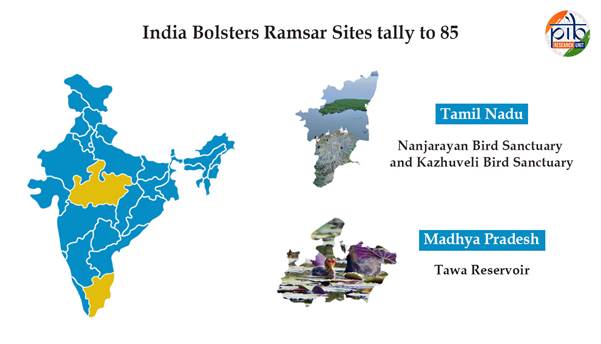
The new additions include two sites in Tamil Nadu viz Nanjarayan Bird Sanctuary (125. 865 Hectares) and Kazhuveli Bird Sanctuary (5151.6 Hectares), both of which are vital for bird conservation and biodiversity. Additionally, Madhya Pradesh has joined the ranks with the inclusion of Tawa Reservoir (20050 Hectares), a crucial wetland for supporting local wildlife.
These additions underscore our dedication to preserving the unique ecosystems that play a vital role in our environmental health and biodiversity.
A Glance at Three Ramsar Sites
Nanjarayan Bird Sanctuary
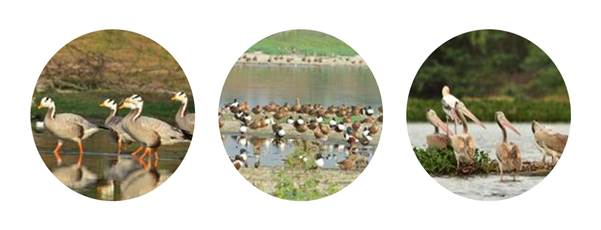
Nanjarayan Bird Sanctuary is a large shallow wetland located in the northeastern region of Uthukuli Taluk, Tiruppur District, Tamil Nadu.
Situated about 10 km north of Tiruppur city along the Tiruppur-Uthukkuli main road, the lake spans 125.865 hectares and lies between the villages of Sarkar Periyapalayam and Neruperichal. It was historically restored by King Nanjarayan, from whom it derives its name.
The sanctuary supports a rich biodiversity, with 191 bird species, 87 butterfly species, 7 amphibians, 21 reptiles, 11 small mammals, and 77 plant species recorded.
Further, it serves as a crucial feeding and nesting ground for resident and migratory birds and is a vital water source for local agriculture.
Kazhuveli Bird Sanctuary
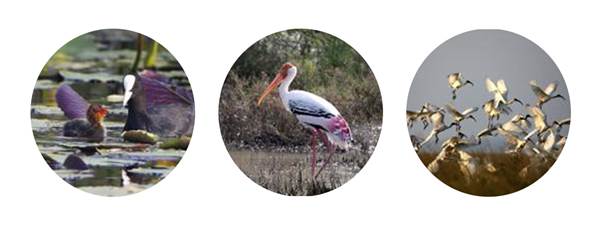
Kazhuveli Bird Sanctuary, covering 5,151.6 hectares, was designated as Tamil Nadu's 16th bird sanctuary in 2021. Located on the Coromandel Coast in Villupuram District, north of Pondicherry, this brackish shallow lake connects to the Bay of Bengal via the Uppukalli Creek and Edayanthittu Estuary.
It is one of the largest wetlands in peninsular India, with diverse water features including estuarine brackish water, sea-fed Uppukalli Creek, and fresh water in the Kazhuveli Basin.
Situated along the Central Asian Flyway, it serves as a critical stopover for migratory birds, a breeding ground for resident species and fish, and a major aquifer recharge source.
Tawa Reservoir
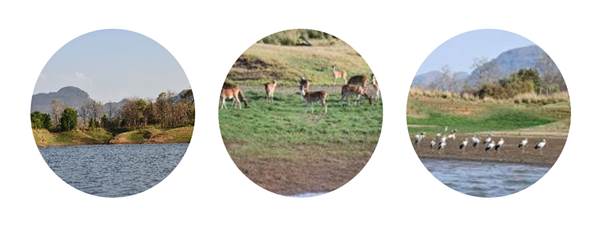
The Tawa Reservoir, located at the confluence of the Tawa and Denwa rivers near Itarsi in Madya Pradesh, serves primarily for irrigation, but also for power generation and aquaculture. The reservoir covers 20,050 hectares with a catchment area of 598,290 hectares.
Originating from the Mahadeo Hills in Chhindwara, the Tawa River is a major left bank tributary of the Narmada River, flowing through Betul and Narmadapuram districts.
Administered by the Forest Department of Narmadapuram, the reservoir lies within the Satpura Tiger Reserve, forming the western boundary of Satpura National Park and Bori Wildlife Sanctuary.
It supports diverse aquatic flora and fauna, including many rare and endangered species, and is a crucial habitat for local and migratory birds. The area is the largest protected zone in Madhya Pradesh and is notable for its ecological, archaeological, historical, and forestry significance.
Wetlands in India
India is home to a rich diversity of wetlands, many of which hold cultural and religious significance.
These wetlands are protected under various national laws, including the Indian Forest Act (1927), the Forest (Conservation) Act (1980), and the Indian Wildlife (Protection) Act (1972).
With the increasing focus on sustainability, India has significantly expanded its network of Ramsar Sites to 85 (as of 14th August 2024), making it the country with the largest number of such sites in South Asia.
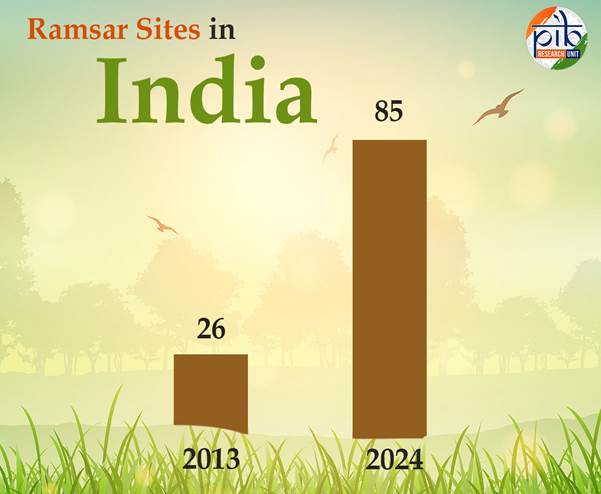
Between 1982 and 2013, India added 26 sites to its list of Ramsar sites. However, from 2014 to 2024, the country has significantly increased its commitment to wetland conservation by adding 59 new Ramsar sites.
Earlier in 2024, India added new Ramsar Sites which include Ankasamudra Bird Conservation Reserve, Aghanashini Estuary and Magadi Kere Conservation Reserve located in Karnataka whereas two, Karaivetti Bird Sanctuary and Longwood Shola Reserve Forest in Tamil Nadu. Two bird sanctuaries from Bihar, Nagi and Nakti were also included in this list.
Notably, India is home to a diverse array of wetlands, with a total of 1,307 across the country. Among these, 113 are recognized as significant wetlands due to their ecological importance and contribution to biodiversity.
Within this group, 85 wetlands have been designated as Ramsar sites, highlighting their international significance for conservation. In addition to these, there are 1,109 other wetlands that contribute to the rich tapestry of India's natural landscapes.
Further, these wetlands are crucial habitats for migratory birds, particularly those traveling along the Central Asian Flyway. These wetlands serve as vital stopover sites where birds can rest and refuel during their long migrations.
Maintaining the health of these wetlands is essential for conserving the bird populations that depend on them.
Recent Developments in Wetland Conservation in India
- Wetlands of India Portal: Launched on October 2, 2021, by the Ministry of Environment, Forest, and Climate Change (MoEFCC), this portal provides comprehensive information on India's wetlands. It includes capacity-building materials, data repositories, and dashboards for each state and union territory.
- National Wetland Decadal Change Atlas: Prepared by the Space Applications Centre (SAC), Ahmedabad, this atlas highlights the changes in wetlands across the country over the past decade.
- Centre for Wetland Conservation and Management (CWCM): Established on World Wetland Day 2021, this center focuses on addressing research needs and knowledge gaps in wetland conservation.
- Wetlands Rejuvenation Programme: Initiated by MoEFCC in 2020, this program aims to rejuvenate over 500 wetlands across India. It includes developing baseline information, rapid assessments, stakeholder engagement, and management planning.
- Integration with River Basin Management: The Namami Gange program integrates wetland conservation with river basin management, serving as a model framework for the entire country.
- National Plan for Conservation of Aquatic Ecosystems: In 2013, the National Wetlands Conservation Programme and the National Lake Conservation Plan were combined to create the National Plan for Conservation of Aquatic Ecosystems. This comprehensive plan reflects a holistic government approach to protecting vital aquatic ecosystems.
- Amrit Dharohar Scheme: Launched with the Union Budget 2023-24, the Amrit Dharohar Scheme is a key initiative aimed at optimizing wetland utilization over the next three years. Its goals include enhancing biodiversity, increasing carbon stock, boosting eco-tourism, and generating income for local communities, in line with the government's sustainable development vision.
- MoEFCC's Wetlands Rejuvenation Programme: Launched in 2020, the Ministry of Environment, Forest & Climate Change (MoEFCC) initiated the Wetlands Rejuvenation Programme. This multifaceted approach includes developing baseline data, assessing wetland health, establishing stakeholder platforms, and creating comprehensive management plans. The program covers over 500 wetlands, showcasing the government's dedication to conserving these essential habitats.
- National Wildlife Action Plan: The National Wildlife Action Plan (2017-2031) emphasizes the conservation of inland aquatic ecosystems, including wetlands. It advocates for a national wetlands mission to preserve these habitats, recognizing their importance for biodiversity and ecosystem services.
- Integration with Namami Gange: On World Wetlands Day 2021, the Ministry of Jal Shakti highlighted the integration of wetland conservation with the Namami Gange program. The National Mission for Clean Ganga (NMCG) has pioneered initiatives that serve as models for wetland conservation nationwide.
This includes developing health cards and management plans for 10 wetlands in each of the 50-plus Ganga districts, blending scientific expertise with community involvement.
Conclusion
Wetlands are essential for managing the impacts of floods, droughts, and cyclones. They serve as natural buffers by capturing excess rainfall and gradually releasing water during dry periods, thus mitigating extreme weather effects. Additionally, wetlands are vital for maintaining ecosystem health, helping to minimize potential disaster impacts on various habitats and species.
The Government of India is committed to integrating the full spectrum of wetland values into developmental planning and decision-making processes. Recognizing the crucial role wetlands play in supporting both human well-being and planetary health, the government has initiated several efforts to protect and restore these vital ecosystems. Through various wetland initiatives, the Government seeks to ensure that the invaluable services provided by wetlands are preserved for future generations.
References
https://pib.gov.in/PressReleasePage.aspx?PRID=2045232
https://pib.gov.in/PressReleasePage.aspx?PRID=2000838
https://pib.gov.in/PressReleasePage.aspx?PRID=1851484
https://www.pib.gov.in/PressReleasePage.aspx?PRID=1847983
https://pib.gov.in/PressNoteDetails.aspx?NoteId=151805&ModuleId=3
https://www.newsonair.gov.in/two-more-indian-wetlands-added-to-ramsar-list/
https://indianwetlands.in/
Click here to see in PDF:
Santosh Kumar/ Sarla Meena/ Abhinandan Sharma
(Backgrounder ID: 152029)
आगंतुक पटल : 40780
Provide suggestions / comments